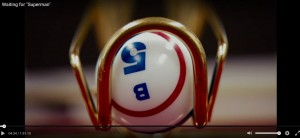Davis Guggenheim’s “Waiting For Superman” examines the underlying problems in the American educational system through following 5 students who are at the age of going to another school. By having education reformers expressing their views, the movie highlights how dysfunctional the public educational system is in the United States.
One of the most emotional scenes in “Waiting for Superman” is when the students who are followed do not get into the schools that would “save them.” Based on research, most public schools fail and students do not perform better since the 1970s (Guggenheim 25:30). However, there are a few charter schools—public schools that are publicly founded but independently run– that show remarkable academic improvement in terms of test scores. The only choice these students have is to get into one of these schools. However, only a limited number of student can enroll to these schools, and who gets in is decided by random lottery. Therefore, some students will have a better chance of education by sheer luck while others are “left behind.”
One of the students who is from a low-income Hispanic family wants to get into a charter school because she wants to be a doctor when she grows up. However, her chances are very low if she does not get into that school. The scene in which the school draws the number is very emotionally filled because the viewer can see the tension and worry on the parents and students’ faces. There is even a count down on the right corner to show how many spots are open. At the end, this girl did not get the spot. She did not win the lottery (Guggenheim 1:34:39).
Guggenheim portrays charter schools as the only and better solution to schooling for low-income students. “Waiting for Superman” claims that not only do charter schools perform as well as the national average but often they outperform other schools because their students’ scores on reading and math are higher. However, Kahlenberg and Potter argue in Smarter Charter that charter schools do not often outperform traditional public schools but in fact students enrolled in charter schools perform about the same as students in traditional public schools (68). They claim that “perhaps the central lesson of research on the performance of charter schools is that just being a charter school is not a guarantee of success any more than being a district school. Student outcomes at individual charter schools—and at individual district schools—vary widely, and results depend on how specific schools are run” (Kahlenberg and Potter, 86). The evidence they provide for their reasoning can be found in national studies that have a broad but mixed scope which often do not control for self-selection bias, studies of individual cities—that are usually not generalizable, and studies of individual charter management organizations—that have a potential but their results are misinterpreted or exaggerated (Kahlenberg and Potter, 69).
Bibliography
Guggenheim, Davis. Waiting for “Superman.” 2010. Film.
Kahlenberg, Richard D., Potter, Halley. A Smarter Charter: Finding What Works for Charter Schools and Public Education. Teachers Collee Press. 2014. Print.

